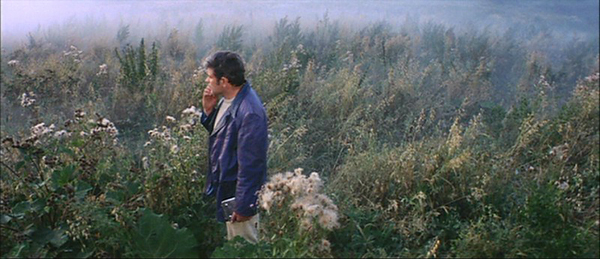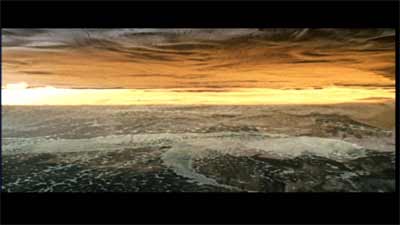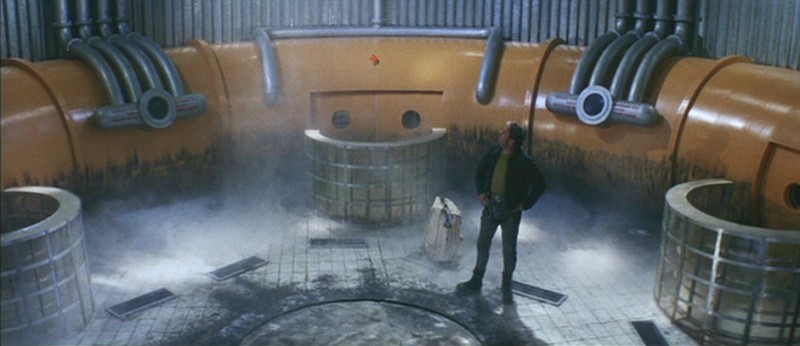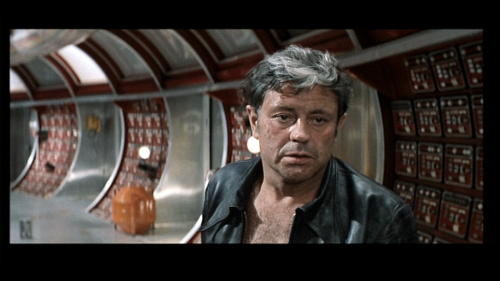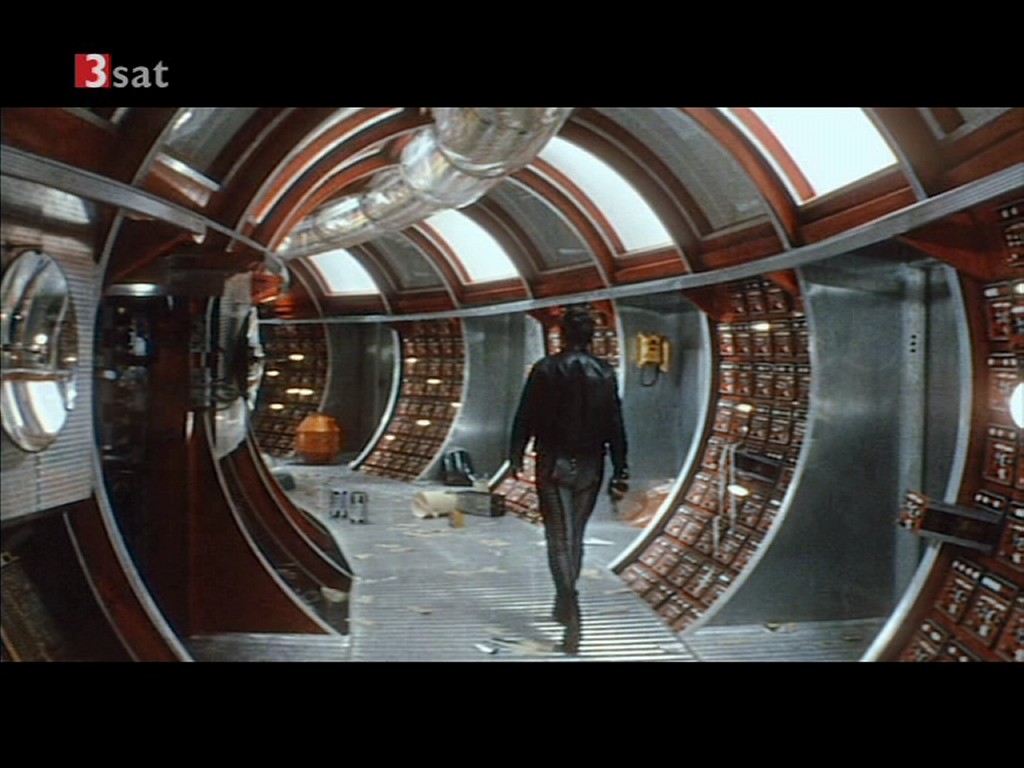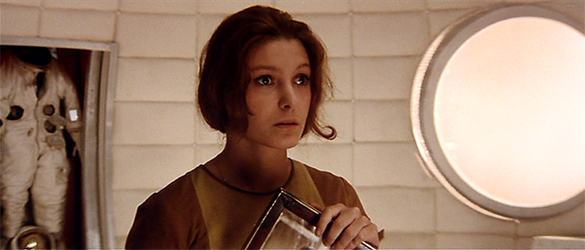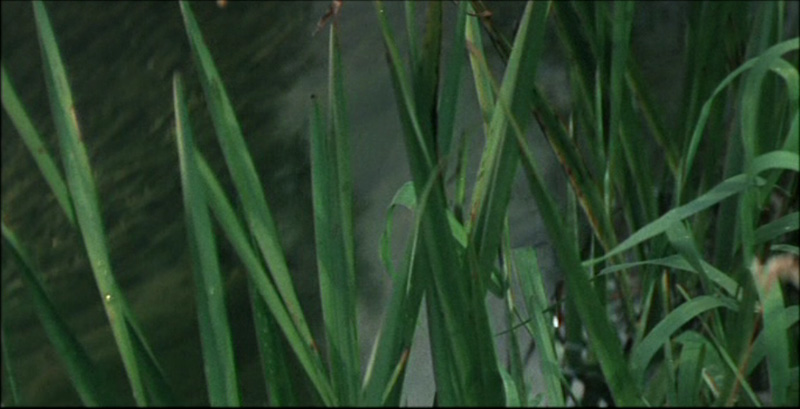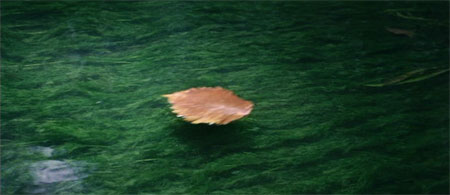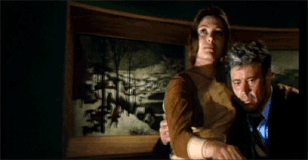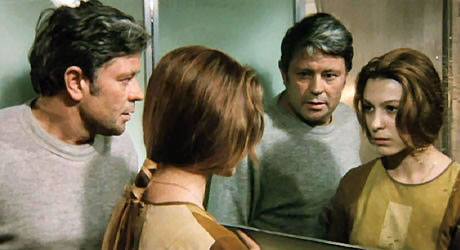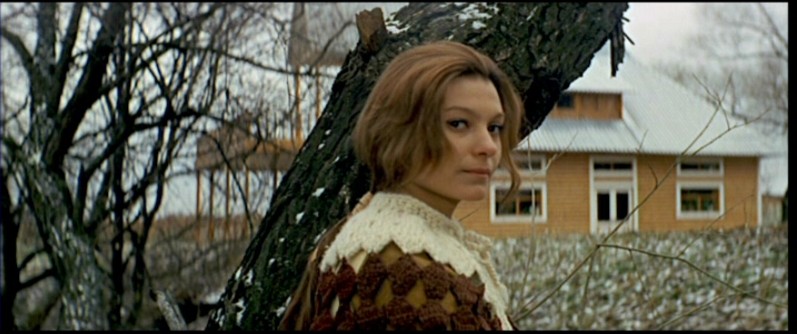From the Chicago Reader (January 12, 1990). I was disappointed to hear from one of the audio commentators on the Criterion DVD of Solaris that he regarded the lengthy highway sequence as one of the film’s “weaker” sections; for me it’s one of the highlights, both as a provocation and as a “musical” interlude that becomes an occasion for hypnotic drift. — J.R.
SOLARIS **** (Masterpiece)
Directed by Andrei Tarkovsky
Written by Friedrich Gorenstein and Tarkovsky
With Donatas Banionis, Natalya Bondarchuk, Yuri Jarvet, Vladislav Dvorzhetsky, Anatoly Solonitsin, and Sos Sarkissian.
“We take off into the cosmos, ready for anything: for solitude, for hardship, for exhaustion, death. Modesty forbids us to say so, but there are times when we think pretty well of ourselves. And yet, if we examine it more closely, our enthusiasm turns out to be all sham. We don’t want to conquer the cosmos, we simply want to extend the boundaries of Earth to the frontiers of the cosmos. For us, such and such a planet is as arid as the Sahara, another as frozen as the North Pole, yet another as lush as the Amazon basin. We are humanitarian and chivalrous; we don’t want to enslave other races, we simply want to bequeath them our values and take over their heritage in exchange. We think of ourselves as the Knights of the Holy Contact. This is another lie. We are only seeking Man. We have no need of other worlds. We need mirrors. We don’t know what to do with other worlds. A single world, our own, suffices us; but we can’t accept it for what it is.” — scientist in Stanislaw Lem’s Solaris (1961)
It’s taken nearly two decades for Solaris (1972), Andrei Tarkovsky’s mind-boggling Soviet “reply” to 2001: A Space Odyssey, to open in this country in its original form; but whatever doubts one might have about this beautiful film, I don’t think anyone could accuse it of being dated. Futuristic technology plays such a minimal role in Tarkovsky’s cosmology that state-of-the-art hardware and fancy special effects are virtually irrelevant to his vision. (One quaint example of the former is the videotapes employed in the film: they all have the shape and size of audiocassettes, but the images they project are in black and white and ‘Scope, and the video screens are correspondingly rectangular.) A handsome wide-screen spectacle set in a remote galaxy, the movie expresses plenty of awe and terror about imponderables, but what’s fundamentally at issue here is the state of man’s soul, not the physical state of the universe.
Having seen Solaris three times over the past 18 years but only in its complete 167-minute form, I can’t describe in any detail the differences between this version and the mutilated predecessors that have been circulating in the U.S. since 1976. I know that the original U.S. distributor hacked away 35 minutes without consulting Tarkovsky, and that subsequent prints that made the rounds of U.S. repertory theaters — partially dubbed, partially subtitled, and cobbled together out of separate versions — were even shorter. Given the film’s difficulties in its complete subtitled version, I have no doubt that its truncated forms must have been pretty incomprehensible.
Based on a Polish science fiction novel of the same title by Stanislaw Lem, Tarkovsky’s provocative head-scratcher can’t really be “explained” by using the original source material as one’s guide. A staunch nonbeliever in film genres (“I do not believe that the cinema has genres — the cinema is itself a genre,” he noted in a 1981 interview), Tarkovsky ironically regarded Solaris as the least successful of his films for the same reason that most people probably want to see it — because of its associations with science fiction. “Unfortunately the science fiction element in Solaris was too prominent and became a distraction,” he wrote in his fascinating (if maddening) book Sculpting in Time. “The rockets and space stations — required by Lem’s novel — were interesting to construct; but it seems to me now that the idea of the film would have stood out more vividly and boldly had we managed to dispense with these things altogether.”
Although portions of Tarkovsky’s film defy synopsis, it is certainly possible to describe the plot, such as it is. The film opens at the idyllic country home of Kris Kelvin (Donatas Banionis), a psychologist, who lives there with his aging parents and his little boy. Unexplained incidents have been taking place on the planet Solaris, where a permanently orbiting space station was established many decades ago, and Kelvin has been asked to travel there alone to investigate, with the idea of closing down the space station after subjecting the planet’s oceanic surface to a final, exploratory burst of radiation.
Before Kelvin leaves, he is visited by Burton (Vladislav Dvorzhetsky), one of the original astronauts sent to explore the planet’s misty, swirling surface some 20 years earlier. Burton had gone out in search of Fechner, another one of the astronauts, who disappeared and was never found. With Burton and his parents, Kelvin watches a videotape of Burton’s report on the mission, in which he describes sighting a 13-foot-high naked male child in a garden on the planet’s surface. At this point in the report, Burton shows his own film of what he saw, but all that is visible are various cloud formations, and the scientific committee watching his report dismiss his account as a hallucination brought about by strain. Later, however, on his way back to the city, he calls back to the country house on a videophone to report that 20 years earlier, after the committee meeting, he had gone to visit Fechner’s family, and Fechner’s son, whom he saw for the first time, was the spitting image of the child he had glimpsed on Solaris.
When Kelvin arrives at the ramshackle Solaris space station, he finds it nearly deserted. The two remaining scientists, Snouth (Yuri Jarvet) and Sartorius (Anatoly Solonitsin), stay cooped up in their laboratories and are unresponsive to most of Kelvin’s questions; a third scientist, Gibarian (Sos Sarkissian), has committed suicide and left behind an enigmatic videotape addressed to Kelvin, which Kelvin plays back. (Much of this portion of the film is steeped in a haunted-house atmosphere: squeaks and other offscreen sounds and barely perceptible movements at the edges of the frame, along with the slow and suspenseful camera movements, all conjure up a sense of the uncanny without spelling it out.)
Eventually Kelvin discovers that the amorphous surface of Solaris is itself a living entity but not one that communicates directly; rather, it materializes human figures drawn from the guilt-ridden memories and fantasies of the astronauts on the space station so that each of them is literally accompanied by his own demon — a process that began after the astronauts first started to expose the planet’s surface to radiation. The demons accompanying the other astronauts are glimpsed so elliptically that we know next to nothing about them: Sartorius is accompanied in his own lab by a dwarf in pajamas; Gibarian is seen briefly on his videotape with a little girl (and the same girl is occasionally seen wandering about the space station, although Gibarian’s corpse is now in cold storage); Snouth’s demon appears to be an adult figure, although we perceive this figure so obliquely that we can’t even be sure of that.
Kelvin’s own demon appears in his cabin while he sleeps, and we see a great deal of her; it is his dead wife Hari (Natalya Bondarchuk), who committed suicide after the failure of their marriage. Initially he is so horrified by her reappearance that he sends her off in a rocket away from the space station, but she materializes before him again; later she attempts suicide again by drinking liquid oxygen, but within moments she comes back to life in a series of spastic jerks. These and other resurrections of Hari occupy most of the remainder of the film, during which time it becomes clear that her double is beginning to have an independent existence and feelings of her own, and Kelvin, who is now determined to remain on the space station, struggles to make amends for his former lack of commitment to her. Finally, however, she succeeds in destroying herself for Kelvin’s sake, leaving behind a letter for him which she gives to Snouth.
Kelvin begins to think again about returning to Earth, and Snouth notes that islands are forming on Solaris’s oceanic surface. On one of these islands, we see Kelvin back beside the pond near his country house. Greeted by his dog, he approaches the house and peers through a window where he makes eye contact with his elderly father; rain is inexplicably falling inside the house, splattering books and teacups — a scene that clearly rhymes with a sudden rainfall outside the country house in the film’s opening sequence — and mist rises from his father as the water falls. Kelvin meets his father at the back door of the house, kneels at his feet and embraces him, and the camera cranes upward, higher and higher until we see the house on an island in the middle of Solaris’s vast ocean.
The fact that we see so much of Hari on the space station and so little of the demons associated with the other astronauts can probably be traced back to the fact that Lem’s novel is a first-person narrative.In keeping with the film’s subjective emphasis, the entire film focuses on Kelvin’s conscience and consciousness, and the objective side of the plot — everything that might be said to constitute the ingredients of a science fiction adventure — gradually comes to seem like nothing more than a pretext for telling Kelvin’s individual story. In the final analysis, whether or not we interpret the final scene as a dream sequence is irrelevant, because by this time the objective and subjective plots have become indistinguishable. The same ambiguity applies to certain sequences in which the living room of Kelvin’s country house merges with various parts of the space station to form an indissoluble whole.
Bearing this ambiguity in mind, it could be argued that Tarkovsky’s Solaris, unlike the Lem novel, qualifies more as anti-science fiction than as science fiction. In this respect, it bears a certain resemblance to some of the stories in Ray Bradbury’s The Martian Chronicles, in which space explorers on Mars hallucinate people from their childhoods. A less obvious yet equally pertinent comparison can be made between Tarkovsky’s vision and a book I consider to be the greatest of all science fiction novels, Olaf Stapledon’s Star Maker (1937) — which significantly has been cited by both Lem and Jorge Luis Borges with admiration, although it has never received much attention in hard-core SF circles.
A speculative account of the entire history and breadth of the cosmos, Star Maker has a canvas so vast that the entire span of mankind, the focus of Stapledon’s earlier Last and First Men (1930), figures here in the space of less than a paragraph, a mere drop in the bucket. The crucial paradox underlying the awesome sweep of the book is that the entire plot is framed by the mundane marital discord experienced by the human narrator. A rustic Englishman leaves his home in the midst of a quarrel to stand on a nearby hillside and gaze at the stars, where he experiences the entire narrative of the book in the form of a vision before returning to the mundanity of his modest life and problems.
Just as important, Stapledon’s humdrum prose becomes the vehicle for his staggering sense of the cosmic. While the contradictory conceit of most science fiction writers trafficking in related subjects is that man can somehow think beyond the limitations of his consciousness in imagining the cosmos, Stapledon’s point of departure is precisely the reverse of this. Accepting the frailty and inadequacy of his vantage point at the outset, Stapledon proceeds to scale the heights like no other science fiction writer before or since, precisely because he knows how to use his limitations as an integral part of his descriptive technique.
Stapledon’s pronounced influence on Arthur C. Clarke can be detected in both Clarke’s novel Childhood’s End and 2001: A Space Odyssey (which Clarke scripted with Stanley Kubrick). But 2001, which imagines an intelligence greater than man’s, ultimately loses sight of the everyday underpinnings essential to Stapledon’s vision. Tarkovsky’s view, on the other hand, which is ultimately a good deal more conservative and pessimistic than either Clarke’s or Stapledon’s, uses the everyday not as a springboard into the cosmic but as a sign of man’s inability to attain such reaches.
The fact that the only universe man can truly explore exists inside his own head is a key to Stapledon’s technique (which Clarke and Kubrick learned from), but not to his vision; in the case of Tarkovsky, it becomes the irreducible message. So it is perfectly logical that Tarkovsky came to regret the science fiction furnishings of Solaris, as provided by Lem, as a vehicle for his vision. Significantly, Lem’s novel is set exclusively on the space station; the action of the film is principally (if misleadingly) set there only so that Tarkovsky can ponder the significance of Kelvin’s country house and family. Consequently, in place of interstellar space travel, we get very slow pans past underwater plants swaying to drifting currents in the pond near this country house, and a lengthy hypnotic sequence that follows a car speeding along a freeway, through several long tunnels, and into a city as night falls. (The city itself is sufficiently anonymous that it could be almost anywhere — Los Angeles, Moscow, Tokyo, Berlin; there are no legible street signs.) Later in the film, inside the space station, the camera drifts endlessly across various details in a reproduction of Brueghel’s Hunters in the Snow, which is hanging in a stateroom along with the three other Brueghel paintings that make up “The Four Seasons.”
None of these meditative moments is motivated conventionally in narrative terms, although the first two are linked to narrative moments: Kelvin is brooding by the pond where the underwater plants are swaying, and Burton is returning from the country to the city with Kelvin’s son in a driverless car. (The selective survey of the painting is “placed” retrospectively by a shot that occurs at the end from a home movie showing Kelvin’s child in the snow.) To say that these moments effectively “replace” interstellar travel in the film is to suggest that they provide poetic rather than narrative substitutes — moments of seemingly endless drift that suspend the film’s narrative flow. All of these camera movements mystically imply a continuous movement toward a revelation that never actually arrives — a kind of spiritual tease. As in Stalker, perhaps Tarkovsky’s greatest film — another work adapted from a science fiction novel that uses the genre’s come-on, the notion and the promise of infinity, only to frustrate this expectation with an insistence on man’s finitude and the poverty of the human imagination — the external journey of the plot, which we see, proves to be secondary to the inner journey of the characters, which we don’t see. Bits of electronic music figure effectively in Eduard Artemev’s score for Solaris, but the essential theme is Bach’s F Minor Choral Prelude.
Another level of ambiguity is introduced by the film’s periodic shifts between color and black and white. As in most of Tarkovsky’s other features (apart from Andrej Roublev, which shifts to color only in its epilogue), few of these switches can be accounted for by any consistent thematic, formal, or atmospheric strategy. A joke used to circulate in Russia that Tarkovsky shifted from color to black and white whenever he ran out of money, and other Russian directors have by their own admission occasionally shifted to black and white in mid-film when they ran out of color stock. In the case of Solaris, some of these transitions occur in the middle of individual shots, which rules out any consistent economic motivation. Whether the reasons behind them are conceptual or arbitrary, they have the overall effect of intensifying the private and esoteric aspects of Tarkovsky’s style — aspects that are clearly related to his spirituality.
To me at least, the notion of spirituality in film has always been more than a little suspect. Filmmakers as diverse as Robert Bresson, Carl Dreyer, Leo McCarey, Kenji Mizoguchi, Yasujiro Ozu, Jean Renoir, Roberto Rossellini, and Michael Snow are frequently praised for their allegedly “transcendental” styles though it seems more appropriate to value them for qualities that suggest the opposites of spirituality and transcendence: the brute materiality of the worlds of Mizoguchi and Renoir, the physicality of McCarey and Ozu, the carnality in Bresson and Dreyer, the skepticism of Rossellini, the relentless mechanisms of Snow. If “pure” transcendence is what one is after, I’m afraid that even the more bogus spirituality of Disney, De Mille, and Spielberg may come closer to the mark.
I’m not trying to argue that a filmmaker’s religious beliefs are irrelevant to his or her art, but it does seem to me that none of the best filmmakers requires religious beliefs in order to be understood or appreciated. Bresson’s Jansenism may play some role in the selection and shaping of his plots, but divine providence is evident in neither the sounds nor the images of Au hasard Balthazar, and both Lancelot du lac and L’argent can easily be read as atheistic. Conversely, Dreyer’s Ordet and Rossellini’s Strangers (Viaggio in Italia) may both conclude with religious miracles, but this doesn’t mean that either Dreyer or Rossellini necessarily believes in them as religious miracles; both filmmakers, in fact, have made statements that suggest the contrary (and Dreyer, as we now know from Maurice Drouzy’s biography and other evidence, was not especially religious). John Huston’s remarkably precise film adaptation of Flannery O’Connor’s novel Wise Blood is the work of a believer “translated” by a nonbeliever, and there is nothing in the film that suggests any obvious sort of betrayal.
But when we come to a spiritual filmmaker like Tarkovsky, the question of acceptance or rejection becomes a bit more complicated. I have to confess that, in his thinking about spiritual and holy matters, Tarkovsky often strikes me as pretentious, egocentric, and downright offensive; his sexual politics are Neanderthal (especially in Nostalghia and The Sacrifice), and his view of piety is generally neither attractive nor inspiring. Yet because he is a passionate, critical thinker about the world we live in and a poetic filmmaker whose images and sounds have the ring of truth, I find it impossible to dismiss him. Even when his films irritate or infuriate me, they teach me something in spite of my objections.
Several years ago, in American Film, critic J. Hoberman offered an intriguing three-way comparison of Tarkovsky, Stan Brakhage, and Hans-Jurgen Syberberg as conservative avant-gardists: “All are seers who see their art — and all of Art — as a quasi-religious calling; all three tend toward the solipsistic, invoking their parents, mates, and offspring as talismanic elements in their films. All three are natural surrealists, seemingly innocent of official surrealism’s radical social program. All three privilege childhood innocence… and all three are militantly provincial. Tarkovsky is as hopelessly Russian as Syberberg is terminally German and Brakhage totally American.”
Hoberman’s comparison is instructive, but I’d like to suggest for consideration another parallel figure whose formal originality and problematic ideology are equally relevant: David Lynch. This is not to suggest that the ideologies of Lynch and Tarkovsky are in any way equivalents: if Solaris can be considered a “humanistic” response to 2001, there is certainly nothing humanistic in the same way or to the same degree about Eraserhead, Dune, Blue Velvet, or even The Elephant Man. Yet virtually all of the attributes assigned by Hoberman to his trio — to which one might add the equally salient trait of male chauvinism — apply to Lynch as well. I’m not claiming that Tarkovsky’s films “transcend” their sexism or their arrogance; these qualities remain, along with the films’ beauties and genuine profundities, and no sort of theory can shake them loose. But they are serious in a way and to a degree that is rare in contemporary movies, and their shortcomings are never a matter of aesthetic compromise or philosophical floundering — both of which can be found in some of the commercial features of Lynch, for instance. It might be added that misogyny plays a less pronounced role in Solaris than in some of Tarkovsky’s other features, in part because of the strength and impact of Natalya Bondarchuk’s remarkably nuanced performance as Hari. Kelvin’s conscience may be the film’s subject, but it is Hari’s character that provides the film with its own conscience; next to her, all the male astronauts register as so many blocks of wood — even (or perhaps especially) when they are engaged in heated philosophical discussions, which is often. Like HAL, the computer in 2001, Hari doesn’t qualify as “human” to the same degree as the other characters, but this doesn’t prevent her repeated deaths and resurrections from being highly affecting — tragic, disturbing, appalling — much as HAL’s death in 2001 winds up moving one more than any of the human deaths in that film. Hari may be, like HAL, nothing more than a human projection that has gained a certain lonely autonomy; but like HAL, she winds up providing us with a powerful lesson about what it means to be human, and what it means to die.


